In the dynamic world of New York City real estate, investors often ponder the perfect moment to acquire properties. Given NYC’s stature as a global financial and cultural epicenter and its ever-shifting market dynamics, strategic investment decisions are paramount. In this article, we delve into the pivotal factors shaping real estate investment in New York City and explore whether the current market landscape offers lucrative prospects for investors.

Understanding Real Estate Investment in New York City
New York City stands as a beacon for real estate investment, boasting iconic landmarks and diverse neighborhoods. From upscale condos overlooking Central Park to trendy loft spaces in Brooklyn, the city presents a myriad of investment options catering to diverse preferences and budgets.
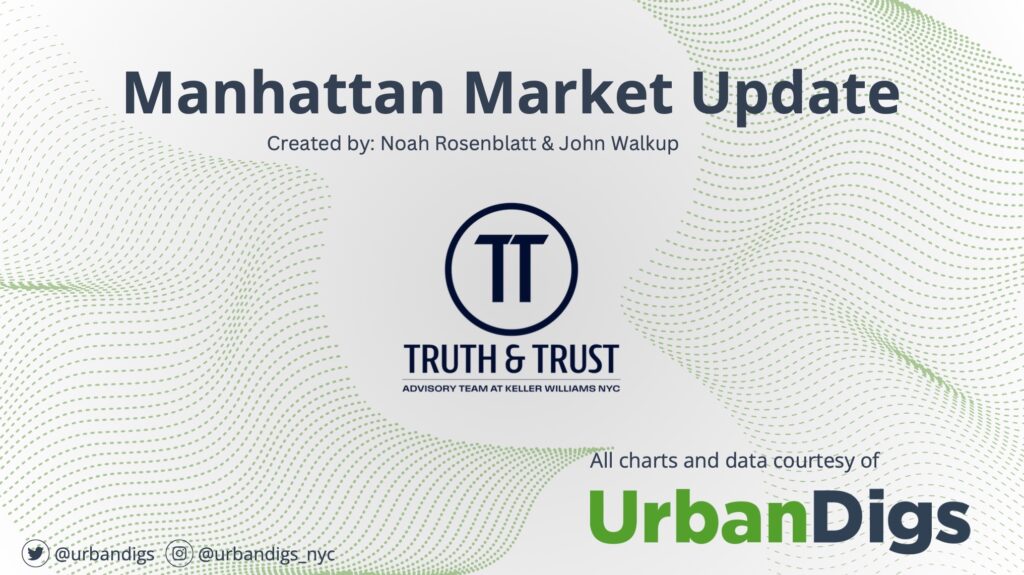
Analyzing Market Trends
To assess the viability of NYC real estate investment, it’s essential to analyze market trends and indicators. Let’s delve into crucial charts providing insights into the current market scenario:
- The Manhattan Listing Climate provides a snapshot of market sentiment, revealing whether buyers or sellers hold the upper hand. It reflects the dominance of one group over the other, influencing negotiation power and transaction outcomes. Understanding this sentiment is crucial for navigating the real estate landscape, as it dictates pricing dynamics, competition levels, and overall market conditions, guiding decision-making for stakeholders in Manhattan’s dynamic market.
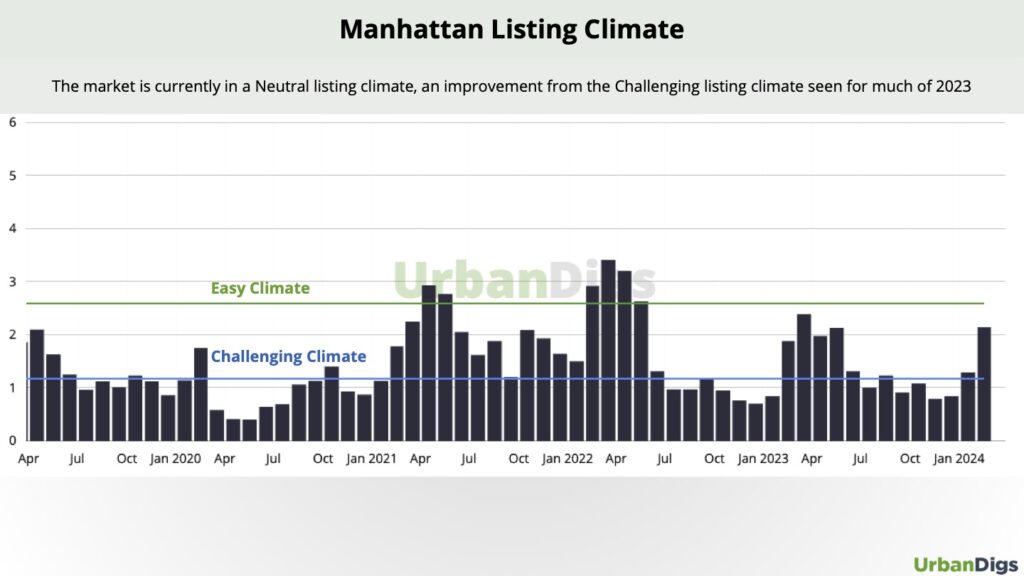
- Manhattan’s supply dynamics directly shape pricing and competition by impacting inventory levels. Fluctuations, influenced by factors like construction and turnover rates, dictate buyer and seller strategies. High inventory offers buyers more options, potentially leading to price decreases and increased seller competition. Conversely, low inventory leads to higher prices and heightened buyer competition.
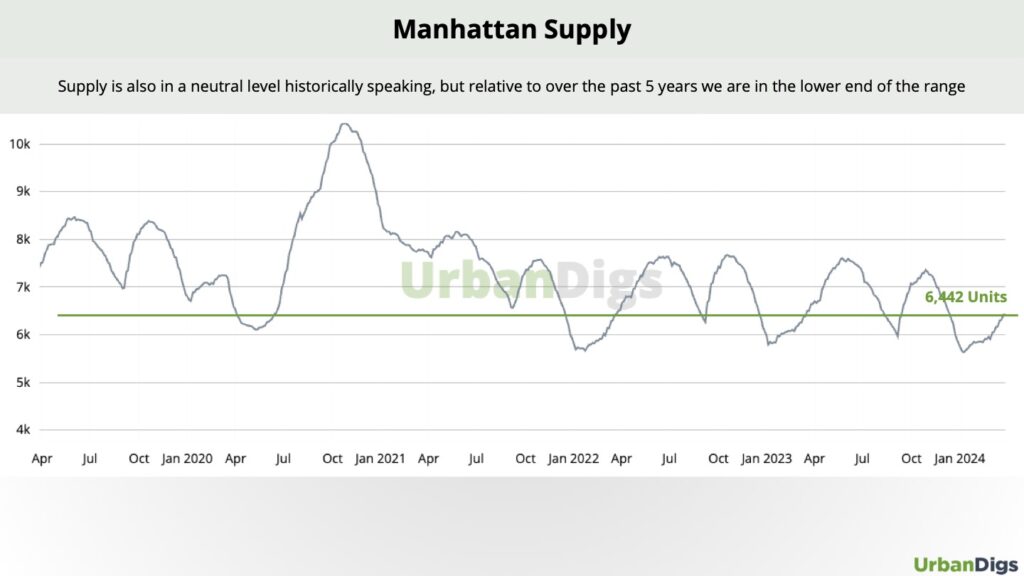
- Manhattan Deal Volume reflects transactional activity, serving as a barometer of market vibrancy and investor confidence. It measures the number of real estate transactions occurring within a specified period, providing insight into market liquidity and the level of investor participation. High deal volume indicates a robust market with ample liquidity, signaling strong investor confidence and market vibrancy, while low deal volume may suggest subdued activity and potential hesitancy among investors. This metric is essential for gauging the health and vitality of Manhattan’s real estate market and informing investment decisions.
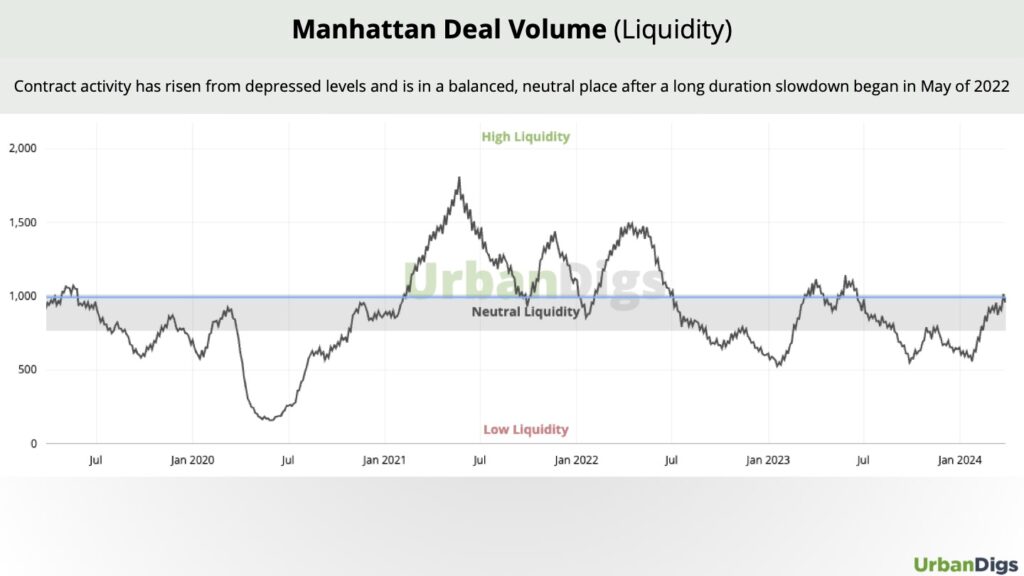
- Manhattan Contracts vs Seasonal Trend compares contract signings to seasonal fluctuations, unveiling patterns in buyer behavior. By analyzing how contract activity deviates from typical seasonal trends, such as increased activity in spring and summer months, it provides valuable insights into shifts in buyer demand and market sentiment. This comparison aids in understanding whether buyer behavior is in line with seasonal expectations or if there are notable deviations that could indicate broader market dynamics at play, guiding strategic decisions for both buyers and sellers in Manhattan’s real estate market.
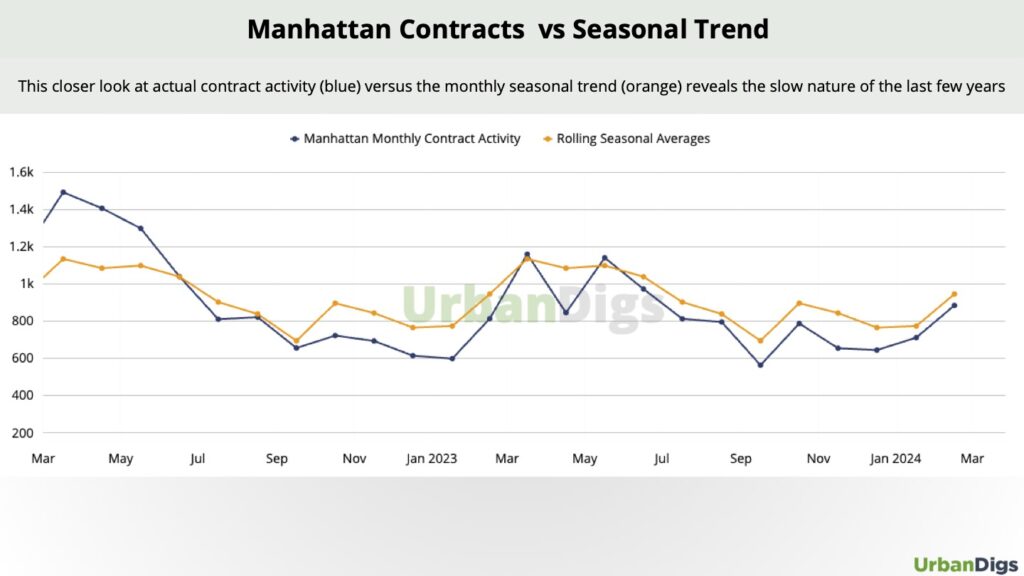
- Manhattan Resale PPSF, or Price Per Square Foot, is a vital metric for tracking price movements in the real estate market, aiding in property valuation by providing insights into pricing trends and market dynamics. It allows stakeholders to assess property values accurately, considering factors like location, size, and amenities. Monitoring PPSF trends over time offers valuable information on market fluctuations and investment opportunities, assisting in decision-making for buyers, sellers, and investors in Manhattan’s competitive real estate landscape.
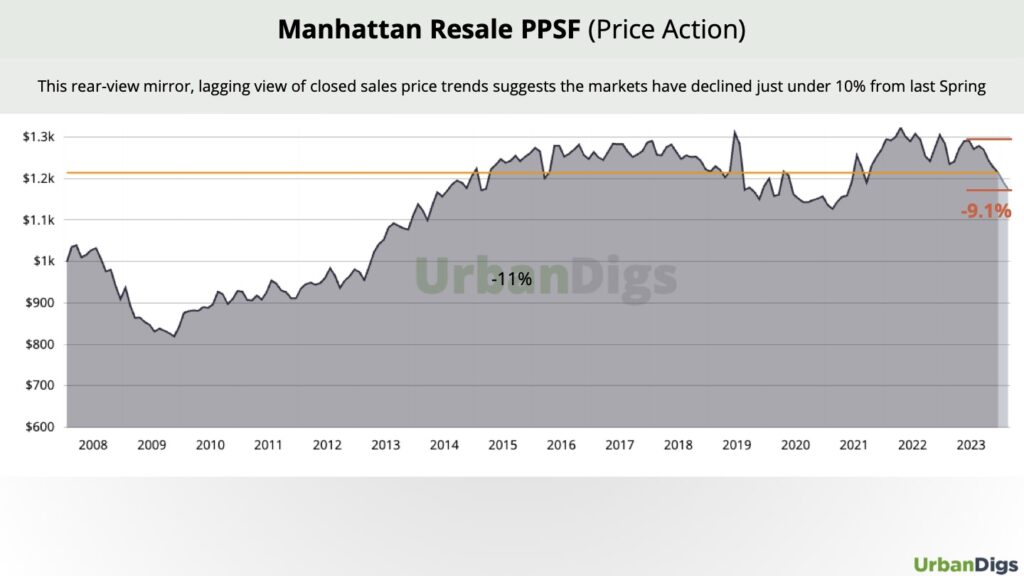
- Manhattan Negotiability %, or Listing Discount, measures pricing negotiation flexibility, impacting buyer strategies. It reflects the percentage difference between listing and selling prices, influencing buyer tactics by indicating potential for price adjustments and savings. This metric guides buyers in optimizing purchasing power and securing favorable deals in Manhattan’s competitive real estate market.
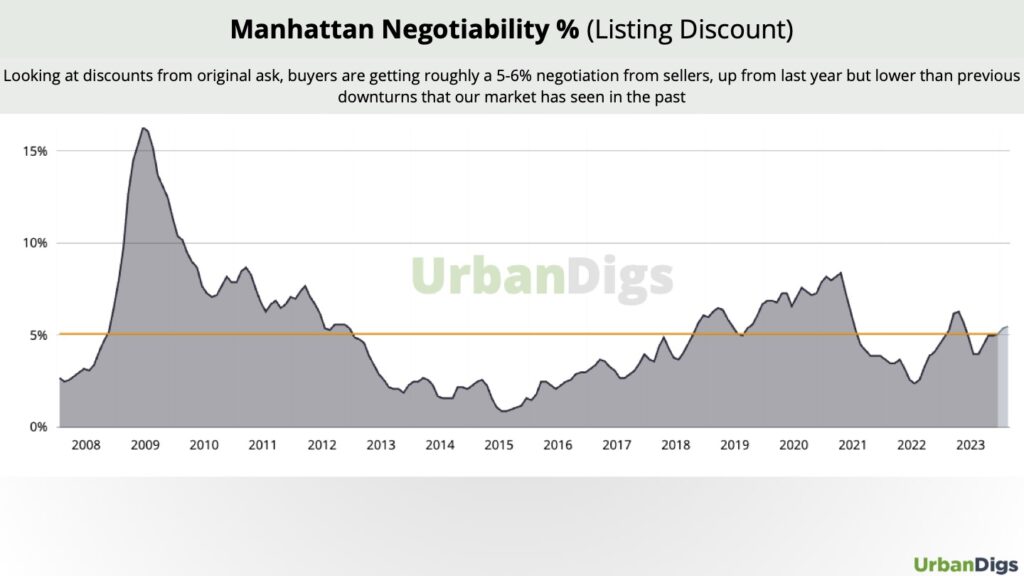
- Market Penalty for Pricing Wrong emphasizes the consequences of inaccurate pricing on property saleability. It underscores how mispricing a property can deter potential buyers, prolonging its time on the market and potentially leading to price reductions. This penalty highlights the importance of pricing properties accurately from the outset to maximize their market appeal and expedite the selling process.
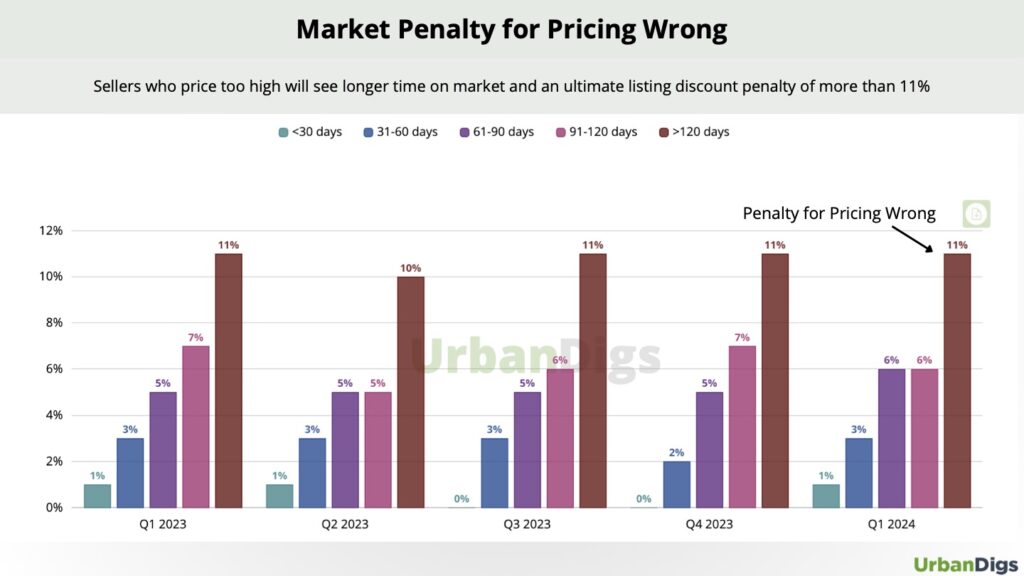
- Time on Market refers to the average duration that properties remain listed before being sold, offering insights into market liquidity. It serves as a key indicator of market activity and demand, reflecting how quickly properties are being bought and sold. A shorter time on market suggests high demand and liquidity, while a longer duration may indicate lower demand or pricing issues. This metric is crucial for both buyers and sellers in understanding the current market conditions and making informed decisions regarding pricing, timing, and negotiations.
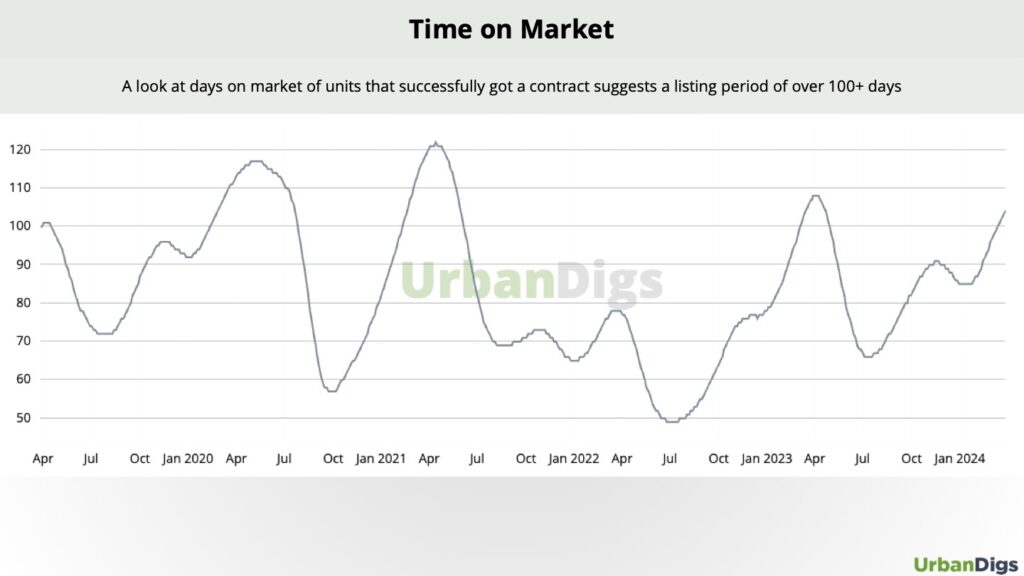
- Understanding the seasonal listing patterns in the real estate market is crucial for strategic investment timing. By recognizing when listings tend to increase or decrease throughout the year, investors can capitalize on favorable market conditions, such as lower competition or higher inventory, to make informed buying decisions. This insight allows investors to align their purchase timelines with optimal market dynamics, maximizing the potential for a successful real estate investment.
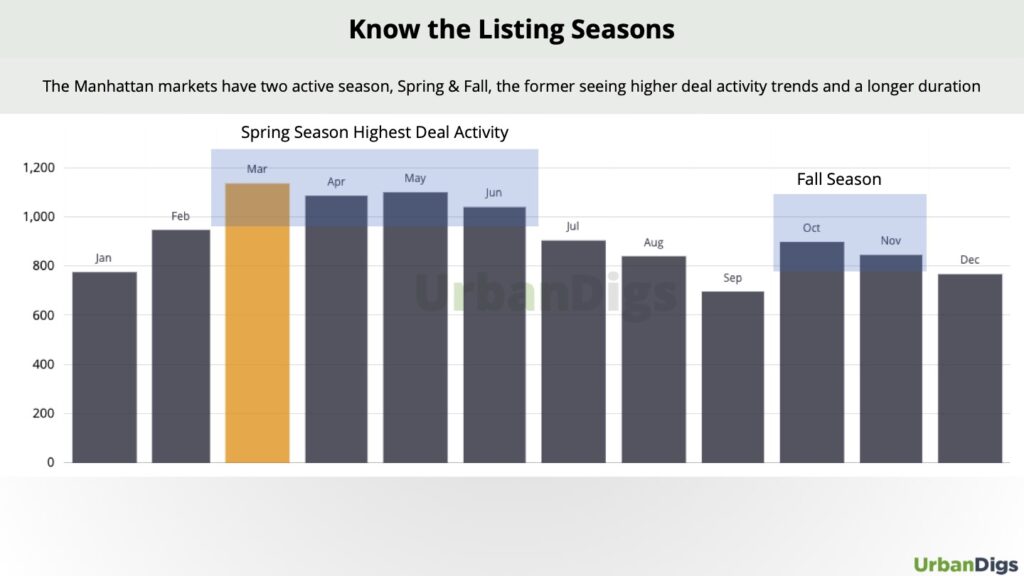
Final Thoughts
Entering 2024, Manhattan’s real estate market presents both opportunities and challenges. Following a prolonged period of declining volume and prices, influenced by factors like rising interest rates, the landscape is shifting.

Here are key insights:
1 – Prices Have Fallen: After peaking in November 2022, resale condo prices dipped by nearly 10%. However, with an anticipated uptick in spring sales, buyers currently have leverage, potentially offering an excellent entry point.
2 – Low Demand Creates Buyer Opportunities: Manhattan’s low demand favors buyers, widening the gap between asking and buying prices. While demand may increase seasonally, buyers currently hold leverage.
3 – An Ice Age of Failed Listings: The “Listing Climate Index” reflects a cooling market for sellers, presenting favorable conditions for buyers. A decline in successful listings suggests seller exhaustion.
4 – Buyer Leverage May Diminish: The seasonally adjusted ratio of demand to supply indicates moderate buyer leverage, expected to diminish with warmer temperatures and increased demand.
5 – Seasonality Impacts Activity: Historical trends show increased activity during spring months, suggesting heightened competition for buyers soon. As seasonality kicks in, the window for leveraging market inactivity may close.
The real estate market is dynamic, requiring strategic planning and trend awareness. Whether you’re experienced or new, Truth & Trust Advisory Team provides insight for informed decisions. With 35+ years in New York’s market, we merge integrity with expertise, offering personalized guidance for seamless success towards your financial goals.
Ready to take the next step in your real estate journey?
Contact us now, and one of our experienced agents will be with you shortly to discuss your needs and set up a meeting to plan your personalized investment strategy.



0 Comments